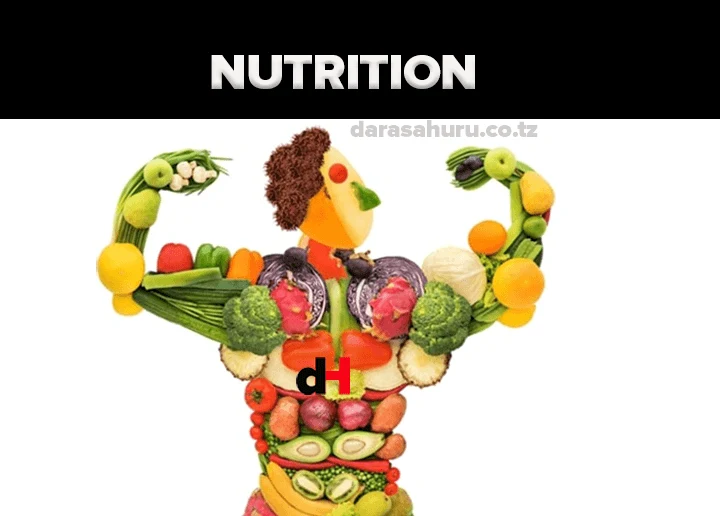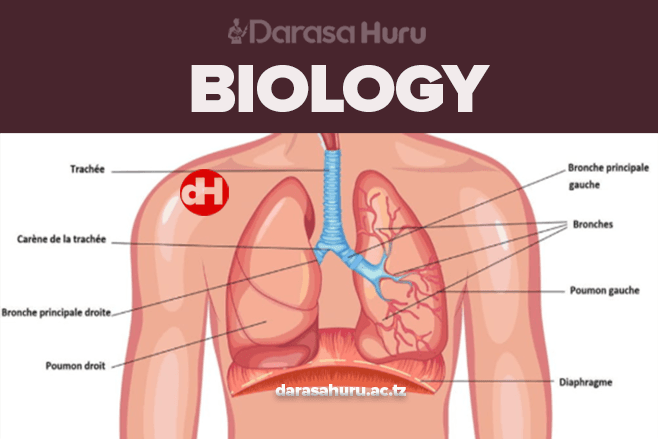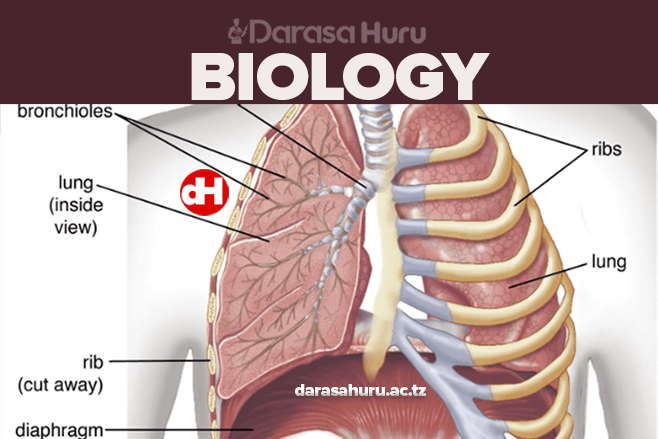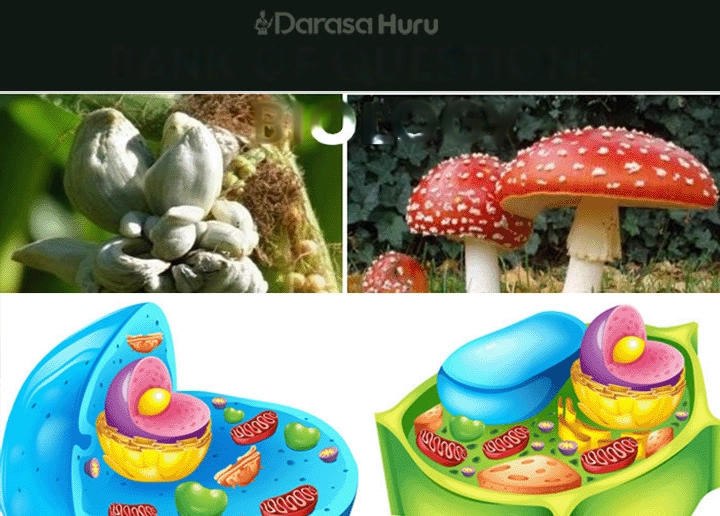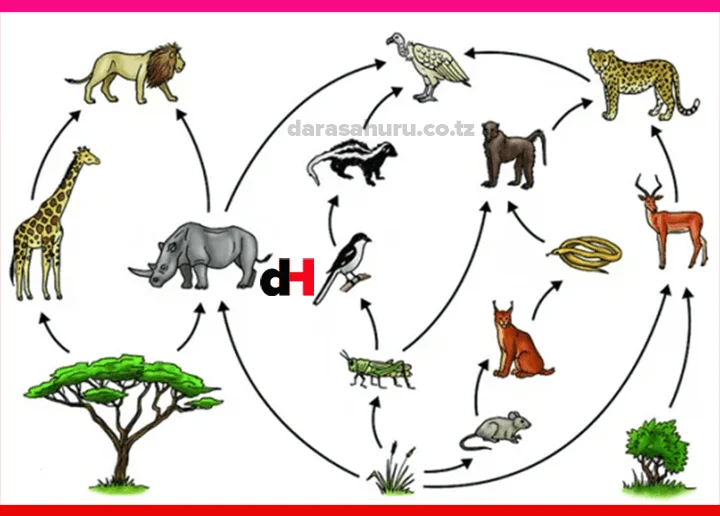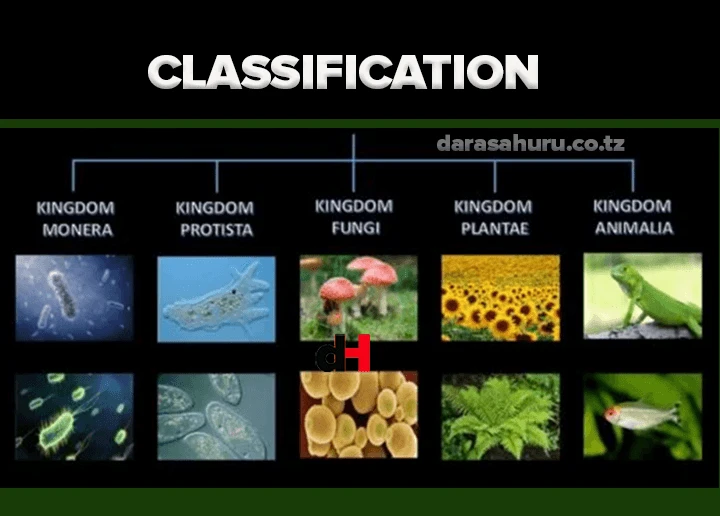Topic 2: Nutrition – Biology Notes Form Two
Concepts of Nutrition and food Nutrients
Meaning of nutrition
FUNCTION OF FOOD
- Oxidized to release energy
- Used in growth of cells
- Used to repair lost cells and tissue
TYPES OF NUTRITION
- Prevent diseases
- Helps growth and development of cells, tissue and organs
- It helps to repair damaged parts
- It helps to protect the body against infection and diseases
Nutrition in Mammals, Human Nutrition
- It is used in body building
- Used by body for tissue growth and repair such as healing of wounds and replacement of skin
- Used as a source of energy, especially when the body lacks carbohydrates and lipids
- It enables red blood cells to transport oxygen in our bodies
CARBOHYDRATES
- They are chief source of energy
- In plants they are stored as starch
- In animals they are stored as glycogen
LIPIDS
- Lipids are used as a source of energy
- Protect the organs such as heart and kidneys
VITAMINS
VITAMIN |
SOURCE |
FUNCTION |
SIGN OF DEFICIENCY |
| Vitamin A(Retinol) | Liver, Milk Carrots,Orange and Yellow Vegetables | Essential for the formation of membranes of the eyes and the respiratory tract | – Night blindness- Increased risk of infections |
| Vitamin B1(Thiamine) | Lean meat,liver, eggs,tomatoes,yeast extract sand brown rice | Carbohydrates metabolism of all foods and release of energy to cells | – Beriberi- Loss of Appetite – Muscle cramps- Heart failure |
| Vitamin B2(Riboflavin) | Liver,meat,wholegrain,cereals,yeast extracts | Needed for metabolism of all foods and release energy to cells | – Cracks and sores around the mouth and nose- Visual problems |
| Vitamin B6(Pyridoxine) | Meat,vegetables,yeast extracts,whole grain cereals | Essential in protein metabolism | – Nerve irritability- Sores in the mouth and eyes- Anaemia |
| Vitamin B12(Cyanocobalamin) | Fish, meat,eggs, milk and liver | Builds genetic materials, help to form red blood cells | – Anaemia- Nerve damage- Weight Loss |
| Vitamin C(Ascorbic Acid) | Pawpaw,Citrus fruits,Fresh Green,vegetables,tomatoesandpotatoes | – Increaseresistant to diseases.- Improve absorption of iron.- Used insynthesis ofcollagen in thebones and gums | |
| Vitamin D(Calciterol) | Egg yolk,milk, oilfish andliver | Helps to build and maintain teeth and bones | – Rickets in children- Osteoporosis (soft bones) in adults |
| Vitamin E(Tocopherol) | Sunflower oil, butter,brown rice and peanuts | – Antioxidant- Preventsdamage of cellmembrane | – Nerve abnormalities- Infertility in rats |
| Vitamin K | Green vegetables and liver | Needed for normalblood clotting | Defective blood coagulation resulting in excessive bleeding. |
MINERALS
Examples of minerals, their source and their function in the body
MINERAL |
SOURCE |
FUNCTION |
SIGN OF DEFICIENCY |
| Calcium | Milk,Cheese,eggs andgreen vegetables | – Helps build strong bones and teeth- Important inclotting of blood | – Weak bones- Bleeding easily |
| Phosphates | Meat, Milk,Fish, Eggs and nuts | – Builds bones and teeth- Helps in muscle and nerve activity | – Poor bone and teeth formation |
| Potassium | Peanuts,bananas,orange juice and green beans | Needed for nerve and muscle function | – Poor muscle contraction |
| Iron | Liver,kidney,beans and green vegetables | Essential for making hemoglobin | – Anemia |
| Zinc | Meat, yeast | Helps to heal wounds | – Skin problems |
| extrac tsand crab | |||
| Sodium | Table salt | – For nerve and muscle activity | – Muscle cramps |
| Chlorine | Table salt | Formation of hydrochloric acid in the stomach | – Poor digestion of protein |
| Magnesium | Spinach,pumpkin seeds, black beans | – Relaxation of nerves and muscles- Strengthening of bones | – Muscle weakness- Irregular heartbeat- Weak bones |
| Copper | Meat, fish and liver | Activation of enzyme | – Anemia- Bone and joint problems |
| Manganese | Kidneys,liver, tea,coffee, nuts and fruits | Formation of bones | – Nausea- Dizziness- Loss of hearing |
| Iodine | Iodized table salt and sea food | Production of thyroid hormones which regulate growth | – Goitre (enlarged thyroid gland) |
ROUGHAGE
- Used in digestion of food
- Used in transport of material in the body
- Used as solvent in chemical reaction
The Concept of Balanced Diet in Terms of Food Quality and Quantity
Explain the concept of balanced diet in terms of food quality and quantity
- Carbohydrates provide energy
- Vitamins needed to keep the body healthy
- Minerals are needed for protection against diseases
- Water is a universal solvent
Nutritional Requirement for Different Groups of People
Explain nutritional requirement for different groups of people
NUTRITIONAL REQUIREMENTS FOR DIFFERENT GROUPS OF PEOPLE
The following nutritional requirement
Expectants: There diet should contain more protein and minerals (Calcium (Ca) and Iron (Fe))
Lactating Mothers: Their requirements are like those of expectants butin greater amount to feed the body
Children: Require a lot of proteins for growth and development of body tissue.
The elderly People: They require adequate amounts of vitamins and minerals to maintain their health
Sedentary workers: These are individuals who stay in one place for along time while performing their daily occupational activities. Due to their lifestyle and occupation,obesity is increasingly common among them, they limit their intake of food rich in lipids.
Sick people: They need special and plenty of nutrients to help recover their health, those who have incurable diseases such as HIV/AIDS should get food that will help them to manage their conditions. They need to take plenty of fruits and water.
Different Types of Nutritional Deficiencies and Disorders in Human Beings
Outline different types of nutritional deficiencies and disorders in human beings
NUTRITIONAL DEFICIENCIES AND DISORDERS
- Eating too little
- Eating too much
- Eating one type of food
- Excessive feeding causes obesity
- Under nutrition causes deficiency diseases
CAUSES, SYMPTOMS, EFFECTS AND PREVENTION MEASURES OF NUTRITIONAL DEFICIENCIES AND DISORDERS IN HUMAN BEINGS
DISEASE |
CAUSES |
EFFECTS |
SYMPTOMS |
PREVENTION |
| Kwashiorkor | Shortage of protein in diet | – Poor growth- Diarrhea- Loss of appetite- Pale skin- Dry skin- Change colour and texture- Body becomes weak and stomach protrudes |
– Consumption offoods rich in protein | |
| Marasmus | – Lack of and equate amount of food- Ignorance of balanced diet preparation of food, food hygiene | – Weight loss- Slowed growth-Decrease dactivity- Lac k of energy – Shrunk enbuttocks | – Getting adequate amounts of food – Balanced diet | |
| Rickets | Lack of vitamin D,Phosphates and Calcium | – Bow legs- Knock knees- An odd shaped skul- Deformed spine | – Provide food rich with vitamin D,Phosphates and Calcium | |
| Scurvy | Lack of vitamin C | – Pain in joints- Stunted growth- Bleed in gums | – Provide diet which containsfruits- Avoid prolonged cooking | |
| Goitre | Lack of iodine | – Swelling of the thyroid gland | – Provide iodized salt and water(H2O) |
Digestive System in Human
- Stomach has sphincter muscles to prevent food from flowing back into the oesophagus
- Stomach has gastric glands, which produce gastric juice for the digestive process.
- Also in the stomach of a young baby there is renin which coagulates milk
- Stomachs have mucus which protects it from corrosion by digestive enzymes
- There is hydrochloric acid for the emulsification of fats and killing ofbacteria
ADAPTATIONS OF ILLEUM TO ITS FUNCTIONS
The following are the adaptations of ileum to its mode of functions:-
- It has secretory glands, which produce digestive enzymes
- It is connected to the liver by the bile duct which enable the bile to reach ileum
- It has finger like projections called villi for the absorption of food
- The ileum is very long to ensure sufficient absorptions of food
- The villi have large network of blood capillaries for transporting absorbed food to all parts of the body
- The inner lining of the ileum is folded to increase the surface area forabsorption
The Digestion Process in Human Being
Explain the digestion process in process in human being
- Have salivary amylase enzyme that converts starch into maltose
- To moisten the food
- To provide medium for enzyme reactions
- Have mucus to lubricate food for easy swallowing
- Saliva consists of Sodium and Calcium salt to ensure alkaline mediumfor amylase enzyme
Difference Between the Human Digestive System with that of Other Mammals
Compare the human digestive system with that of other mammals
- Ruminants have more elaborate system to enable cellulose digestion
- The stomach of ruminants have four chambers (rumen, reticulum,omasum, abomasum)
- The food is regurgitated, chewed, and again then passed to omasum.
Common Disorders and Diseases of the Human Digestive System
Outline common disorders and diseases of the human digestive System
This is commonly referred to as tooth decay. It occurs when bacteriadestroy the outer part of the tooth.
Stomach ulcers
Refers to the sore in stomach lining. It is caused by erosion of stomachwall due to enzyme reactions.
Flatulence
This is caused by excess gas in the digestive tract
Causes, Symptoms, Effects and Control Measures of Common Disorders and Diseases of the Human Digestive System
Explain causes, symptoms, effects and control measures of common disorders and diseases of the human digestive system
SYMPTOMS OF DENTAL CARIES
- Tooth ache
- Holes in the teeth
- Regular brushing of teeth
- Damaged teeth can be filled with artificial crown
- Minimization of intake of foods rich in sugar
- Avoid eating very hot or cold foods
- Have regular dental check ups
- Burning pain in the stomach
- Nausea and vomiting
- Tiredness and weakness
- Blood in vomit or stool
- Medication
- Avoid smoking
- Avoid taking alcohol
- Avoid eating acidic foods
- Lack of bowel movements for two or three days
- Hard stools
- The urge to go for long call even after you have just been to the toilet
- Eat enough fibre
- Drink enough water
- Exercise regularly
- Seek medical help
- Swallowed air
- Eating food that causes gas such as beans, cabbage, milk and onions
- Poor absorptions of carbohydrates
- Abdominal pain
- The constant urge to pass wind
- Excessive belching
- Accumulation of gas in the stomach
- Avoid foods that produce gas
- Chewing food properly
- Limit the amount of food which are
Nutrition in Plant, Mineral requirement in Plants
- Micro nutrients or minerals
- Macro nutrients
Macro nutrients are minerals that are required in a large quantity for the plant growth.
element |
role |
Deficiency |
| nitrogen | Protein synthesis Manufacture of chlorophyll Promotes normal plant growth | Leaves become pale green, yellow, small leaves, thin weak stem and stunted growth |
| phosphorus | Promote root and branch growth Protein synthesis and energy release in respiration | Poor growth of roots,leaves and branches Leaves become reddish puple |
| Potassium | Used during photosynthesis and protein metabolism inyounger lieves | Yellow leaves with dead spots especially at marginsand tips |
| Calcium | Promotes normal plant growth and cell wall formation | Poor root growth Death of growing regions |
| Magnesium | Manufacture chlorophyll | Yellowing of leaves |
| Sulphur | Protein synthesis | Stunted growth Yellow patchers on leaves |
Photosynthesis
FACTORS FOR PHOTOSYNTHESIS
- All organisms which are heterotrophy depend on autotrophy as source offood.
- Living organisms depend on oxygen for their aerobic respiration producedduring photosynthesis
- . Photosynthesis convert light energy into chemical energy which is used byother organisms
- . Humans depend on photosynthesis for the energy containing fossil fuelwhich have developed over a millions of year.
Properties of Food Substance
Basic food substances:
- Carbohydrates
- Protein
- Lipids
CARBOHYDRATES
TYPES OF CARBOHYDRATES
- Monosaccharide
- Disaccharide
- Polysaccharide
MONOSACCHARIDE:
- They are not soluble in water
- They are non reducing sugar
- . They are not sweet
- When put in water they form suspension
Common Reagents and Chemicals used to Determine Food Properties
Identify common reagents and chemicals used to determine food Properties
TEST FOR CARBOHYDRATES
PROCEDURE |
OBSERVATION |
CONCLUSION |
| Dissolve the food sample in water Add an equal amount of Benedict solution to the solution | Food sample dissolveColor change from blue to green to orange,yellow and finally brick red | Reducing sugar is present |
| Dissolve the food sample in water to getsolution Put 2 cm of a solution obtained in a test tube Add 1 cm of HCL acid | FIZZING COLORCHANGE FROM BLUE,GREEN,YELLOW,orange and finally brick red | Non reducing sugar is present |
| Boil the mixture Allow the mixture to cool Add small amount of sodium hydroxide,shake the test tube after every additional continue until fizzing stops Add 2 cm of Benedict solution then boil the mixture |
FizzingColor change from blue, green to yellow to orange and finally brick red | Non reducing sugar is present |
| TEST B FOR STARCH Add small amount of food sample solution in a test food.Add few drops (2-3)of iodine solution in the food sample |
Color change from blue to black | Starch is present |
Food Tests for Reducing Sugars, Non Reducing Sugars, Starch, Proteins and Lipids (Fats and Oil)
Carryout food tests for reducing sugars, non reducing sugars, starch, proteins and lipids (Fats and Oil)
PROTEINS
Food Processing, Preservation and Storage.
The Concept of Food Processing , Food Preservation and Food Storage
Explain the concept of food processing , food preservation and food storage
Some of activities involved in food processing are;
- Picking, sorting and washing fruits and vegetables
- Cooking by boiling steaming, roasting backing or frying
- Converting raw materials into other products for example making cheersfrom milk or sugar from sugar cane
FOOD PRESERVATION
Methods of food preservation
- Keeping out micro organisms for example by canning or bottling
- Using high temperature to kill microorganisms that cause spoilage eg.By pasturalization and boiling
- Using very low temperature to slow down the growth of microorganisms for example refrigerationiv.
- Irradiation which is by using radiations such as gamma rays to killmicro organismsv
- Eliminating the moisture that is needed for growth of micro organismfor instance by drying, salting, smoking etc
- Adding chemicals such as salt sugar, carbon monoxide to preventphysical changes in food
FOOD STORAGE
- prevents wastage of food
- it saves money by preventing spoilage of food
- maintains the quality of food
- prevents the growth of micro organisms that can cause illness
- improve the flavor of food
- removes armful toxins and micro organisms from food
- makes food available even where they are not in season
- enables transportation of delecate and perishable food such as milk andfruit over long distance
Traditional and Modern Methods of Processing, Preserving and Storing Food
Differentiate between traditional and modern methods of processing, preserving and storing food
They are two methods of food processing and preservation which are;
- traditional methods
- modern methods
I. TRADITIONAL METHODS
ADVANTAGES OF TRADITIONAL METHODS OF FOOD PROCESSING ANDPRESERVATION AND STORAGE
- They are simple and they can be done by most people
- They use locally available materials and simple technology thus keeping costslow
- No harmful chemicals are added to the food
- Curing and smoking add distinct flavor.
- Most methods do not destroy nutrients
- Food can be preserved and stored for the limited period of time
- They are manual and thus difficult to apply on a large scale
- Traditional methods are highly limited in the variety of food that can beprocessed preserved and stored.
II. MODERN METHODS OF FOOD PROCESSING AND PRESERVATION
- Food can last for many months and even a year
- Modern methods can process, preserve, and store large variety of food.
- They are advanced technology bused in fast and can handle huge quantities of food.
- The chemicals used can be harmful if eaten in excess
-
These
- advanced technology involve means where they are used only in certain
- areas for instance refrigeration requires electricity.
- The process used for example canning and pasteurizing require special skills.
- Sometimes nutrients are lost thus lowering the nutritional value of food
DIFFERENCES BETWEEN TRADITIONAL AND MODERN METHODS OFFOOD PROCESSING AND PRESERVATION
TRADITIONAL METHODS |
MODERN METHODS |
| Less costiful | High cost iful |
| It involves the use of low technology | It involves the use of advanced technology |
| It processes and preserves food for alimited amount of time | Preserves food for months and evenyears |
| It uses local materials to process and preserve food It is used by most people | It uses chemicals to process and preserve foodIt is used by few people |
| It select type of food to be processed and preserved | It is not selective
|

